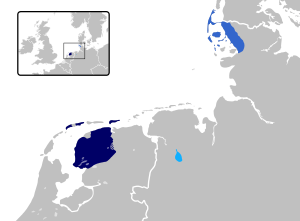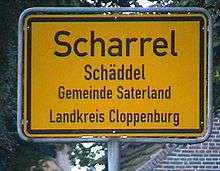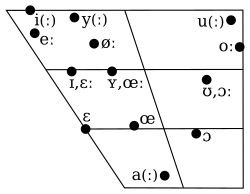Saterland Frisian language
Saterland Frisian, also known as Sater Frisian or Saterlandic (Seeltersk), is the last living dialect of the East Frisian language. It is closely related to the other Frisian languages: North Frisian, spoken in Germany as well, and West Frisian, spoken in the Dutch province of Friesland.
| Saterland Frisian | |
|---|---|
| Seeltersk | |
| Native to | Germany |
| Region | Saterland |
| Ethnicity | Saterland Frisians |
Native speakers | 2,000 (2015)[1] |
| Official status | |
Recognised minority language in | Germany |
| Regulated by | Seelter Buund in Saterland/Seelterlound (unofficial) |
| Language codes | |
| ISO 639-3 | stq |
| Glottolog | sate1242[2] |
| Linguasphere | 52-ACA-ca[3] |
 Present-day distribution of the Frisian languages in Europe:
Saterland Frisian | |
Speakers

Today, estimates of the number of speakers vary slightly. Saterland Frisian is spoken by about 2,250 people, out of a total population in Saterland of some 10,000; an estimated 2,000 people (of whom, slightly fewer than half are native speakers) speak the language well.[4] The great majority of native speakers belong to the older generation; Saterland Frisian is thus a seriously endangered language. It might, however, no longer be moribund, as several reports suggest that the number of speakers is rising among the younger generation, some of whom raise their children in Saterlandic.
Dialects
There are three fully mutually intelligible dialects, corresponding to the three main villages of the municipality of Saterland: Ramsloh (Saterlandic: Roomelse), Scharrel (Schäddel), and Strücklingen (Strukelje). The Ramsloh dialect now somewhat enjoys a status as a standard language, since a grammar and a word list were based on it.
Status
The German government has not committed significant resources to the preservation of Sater Frisian. Most of the work to secure the endurance of this language is therefore done by the Seelter Buund ("Saterlandic Alliance"). Along with North Frisian and five other languages, Sater Frisian was included in Part III of the European Charter for Regional or Minority Languages by Germany in 1998. Since about 1800, Sater Frisian has attracted the interest of a growing number of linguists. During the last century, a small literature developed in it. Also the New Testament of the Bible has been translated into Sater Frisian.
Phonology
The phonology of Saterland Frisian is regarded as very conservative linguistically, as the entire East Frisian language group was conservative with regards to Old Frisian.[5] The following tables are based on studies by Marron C. Fort.[6]
Vowels


Monophthongs
The consonant /r/ is often realised as a vowel [ɐ̯ ~ ɐ] in the syllable coda.
Short vowels:
| Grapheme | Phoneme | Example |
|---|---|---|
| a | /a/ | fat (fat) |
| ä | /ɛ/ | Sät (a while) |
| e | /ə/ | ze (they) |
| i | /ɪ/ | Lid (limb) |
| o | /ɔ/ | Dot (toddler) |
| ö | /œ/ | bölkje (to shout) |
| u | /ʊ/ | Buk (book) |
| ü | /ʏ/ | Djüpte (depth) |
Semi-long vowels:
| Grapheme | Phoneme | Example |
|---|---|---|
| ie | /iˑ/ | Piene (pain) |
| uu | /uˑ/ | kuut (short) |
Long vowels:
| Grapheme | Phoneme | Example |
|---|---|---|
| aa | /aː/ | Paad (path) |
| ää | /ɛː/ | tään (thin) |
| ee | /eː/ | Dee (dough) |
| íe | /iː/ | Wíek (week) |
| oa | /ɔː/ | doalje (to calm) |
| oo | /oː/ | Roop (rope) |
| öö | /øː/ | röögje (rain) |
| öä | /œː/ | Göäte (gutter) |
| üü | /yː/ | Düwel (devil) |
| úu | /uː/ | Múus (mouse) |
Diphthongs
| Grapheme | Phoneme | Example |
|---|---|---|
| ai | /aːi/ | Bail (bail) |
| au | /aːu/ | Dau (dew) |
| ääu | /ɛːu/ | sääuwen (self) |
| äi | /ɛɪ/ | wäit (wet) |
| äu | /ɛu/ | häuw (hit, thrust) |
| eeu | /eːu/ | skeeuw (skew) |
| ieu | /iˑu/ | Grieuw (advantage) |
| íeu | /iːu/ | íeuwen (even, plain) |
| iu | /ɪu/ | Kiuwe (chin) |
| oai | /ɔːɪ/ | toai (tough) |
| oi | /ɔy/ | floitje (to pipe) |
| ooi | /oːɪ/ | swooije (to swing) |
| ou | /oːu/ | Bloud (blood) |
| öi | /œːi/ | Böije (gust of wind) |
| uui | /uːɪ/ | truuije (to threaten) |
| üüi | /yːi/ | Sküüi (gravy) |
Consonants
Plosives
| Labial | Dental/ Alveolar |
Dorsal | Glottal | ||
|---|---|---|---|---|---|
| Stop | voiceless | p | t | k | |
| voiced | b | d | ɡ | ||
| Fricative | voiceless | f | s | x | h |
| voiced | v | z | ɣ | ||
| Nasal | m | n | ŋ | ||
| Trill | r | ||||
| Approximant | (w) | l | j | ||
Today, voiced plosives in the syllable coda are usually terminally devoiced. Older speakers and a few others may use voiced codas.
| Grapheme | Phoneme | Example | Notes |
|---|---|---|---|
| p | /p/ | Pik (pitch) | |
| t | /t/ | Toom (bridle) | |
| k | /k/ | koold (cold) | |
| b | /b/ | Babe (father) | Occasionally voiced in syllable coda |
| d | /d/ | Dai (day) | May be voiced in syllable coda by older speakers |
| g | /ɡ/ | Gäize (goose) | A realization especially used by younger speakers instead of [ɣ]. |
Fricatives
| Grapheme | Phoneme(s) | Example | Notes |
|---|---|---|---|
| g | /ɣ, x/ | Gäize (goose), Ploug (plough) | Voiced velar fricative, unvoiced in the syllable coda and before an unvoiced consonant. Younger speakers show a tendency towards using the plosive [ɡ] instead of [ɣ], as in German, but that development has not yet been reported in most scientific studies. |
| f | /f, v/ | Fjúur (fire) | Realised voicedly by a suffix: ljoof - ljowe (dear - love) |
| w | /v/ | Woater (water) | Normally a voiced labio-dental fricative like in German, after u it is however realised as bilabial semi-vowel [w] (see below). |
| v | /v, f/ | iek skräive (I scream) | Realised voicelessly before voiceless consonants: du skräifst (you scream) |
| s | /s, z/ | säike (to seek), zuuzje (to sough) | Voiced [z] in the syllable onset is unusual for Frisian dialects and also rare in Saterlandic. There is no known minimal pair s - z so /z/ is probably not a phoneme. Younger speakers tend to use [ʃ] more, for the combination of /s/ + another consonant: in fräisk (Frisian) not [frɛɪsk] but [fʀɛɪʃk]. That development, however, has not yet been reported in most scientific studies. |
| ch | /x/ | truch (through) | Only in syllable nucleus and coda. |
| h | /h/ | hoopje (to hope) | Only in onset. |
Other consonants
| Grapheme | Phoneme | Example | Notes |
|---|---|---|---|
| m | /m/ | Moud (courage) | |
| n | /n/ | näi (new) | |
| ng | /ŋ/ | sjunge (to sing) | |
| j | /j/ | Jader (udder) | |
| l | /l/ | Lound (land) | |
| r | /r/, [r, ʀ, ɐ̯, ɐ] | Roage (rye) | Traditionally, a rolled or simple alveolar [r] in onsets and between vowels. After vowels or in codas, it becomes [ɐ]. Younger speakers tend to use a uvular [ʀ] instead. That development, however, has not yet been reported in most scientific studies. |
| w | /v/, [w] | Kiuwe (chin) | As in English, it is realised as a bilabial semivowel only after u. |
Morphology
Personal pronouns
The subject pronouns of Saterland Frisian are as follows:[7]
| singular | plural | ||
|---|---|---|---|
| first person | iek | wie | |
| second person | du | jie | |
| third person | masculine | hie, er | jo, ze (unstr.) |
| feminine | ju, ze (unstr.) | ||
| neuter | dät, et, t | ||
The numbers 1-10 in Saterland Frisian are as follows:[8]
| Saterland Frisian | English |
|---|---|
| aan (m.)
een (f., n.) |
one |
| twäin (m.)
two (f., n.) |
two |
| träi (m.)
trjo (f., n.) |
three |
| fjauer | four |
| fieuw | five |
| säks | six |
| sogen | seven |
| oachte | eight |
| njúgen | nine |
| tjoon | ten |
Numbers one through three in Saterland Frisian vary in form based on the gender of the noun they occur with.[8] In the table, "m." stands for masculine, "f." for feminine, and "n." for neuter.
For the purposes of comparison, here is a table with numbers 1-10 in 4 West Germanic languages:
| Saterland Frisian | Low German | German | English |
|---|---|---|---|
| aan (m.)
een (f., n.) |
een | eins | one |
| twäin (m.)
two (f., n.) |
twee | zwei | two (and the old masculine 'twain') |
| träi (m.)
trjo (f., n.) |
dree | drei | three |
| fjauer | veer | vier | four |
| fieuw | fief | fünf | five |
| säks | söss | sechs | six |
| sogen | söben | sieben | seven |
| oachte | acht | acht | eight |
| njúgen | negen | neun | nine |
| tjoon | teihn | zehn | ten |
Sample text
In the media
Newspaper
Nordwest-Zeitung, a German-language regional daily newspaper based in Oldenburg, Germany, publishes occasional articles in Saterland Frisian. The articles are also made available on the newspaper's Internet page, under the headline Seeltersk.
Radio
As of 2004, the regional radio station Ems-Vechte-Welle broadcasts a 2-hour program in Saterland Frisian and Low German entitled Middeeges. The program is aired every other Sunday from 11:00 a.m. to 1:00 p.m. The first hour of the program is usually reserved for Saterland Frisian. The program usually consists of interviews about local issues between music. The station can be streamed live though the station's Internet page.
Current revitalization efforts
Children's books in Saterlandic are few, compared to those in German. Margaretha (Gretchen) Grosser, a retired member of the community of Saterland, has translated many children's books from German into Saterlandic. A full list of the books and the time of their publication can be seen on the German Wikipedia page of Margaretha Grosser.
Recent efforts to revitalize Saterlandic include the creation of an app called "Kleine Saterfriesen" (Little Sater Frisians) on Google Play. According to the app's description, it aims at making the language fun for children to learn teaches them Saterlandic vocabulary in many different domains (the supermarket, the farm, the church). There have been 100-500 downloads of the app since its release in December 2016, according to statistics on Google Play.
Further reading
- Fort, Marron C. (1980): Saterfriesisches Wörterbuch. Hamburg: Helmut Buske.
- Kramer, Pyt (1982): Kute Seelter Sproakleere - Kurze Grammatik des Saterfriesischen. Rhauderfehn: Ostendorp.
- Marron C. Fort (2001) Das Saterfrisische. In Munske, Horst Haider (ed.), Handbuch des Friesischen, 409-422. Berlin: DeGruyter Mouton.
- Peters, Jörg (2017), "Saterland Frisian", Journal of the International Phonetic Association, doi:10.1017/S0025100317000226
- Stellmacher, Dieter (1998): Das Saterland und das Saterländische. Oldenburg.
See also
| Saterland Frisian edition of Wikipedia, the free encyclopedia |
References
- Saterland Frisian at Ethnologue (21st ed., 2018)
- Hammarström, Harald; Forkel, Robert; Haspelmath, Martin, eds. (2017). "Ems-Weser Frisian". Glottolog 3.0. Jena, Germany: Max Planck Institute for the Science of Human History.
- "s" (PDF). The Linguasphere Register. p. 252. Retrieved 1 March 2013.
- A number of 6,370 speakers is cited by Fort, Marron C., "Das Saterfriesische", in Munske (2001), p. 410. A 1995 poll counted 2,225 speakers: Stellmacher, Dieter (1995). Das Saterland und das Saterländische (in German). Florian Isensee GmbH. ISBN 978-3-89598-567-6. Ethnologue refers to a monolingual population of 5,000, but this number originally was not of speakers but of persons who counted themselves ethnically Saterland Frisian.
- Versloot, Arjen: "Grundzüge Ostfriesischer Sprachgeschichte", in Munske (2001).
- Fort, Marron C., "Das Saterfriesische", in Munske (2001), pp. 411–412. Fort, Marron C. (1980). Saterfriesisches Wörterbuch. Hamburg. pp. 64–65.
- Howe, Stephen (1996). The Personal Pronouns in the Germanic Languages (1 ed.). Berlin: Walter de Gruyter & Co. p. 192. ISBN 9783110819205. Retrieved 29 May 2017.
- Munske, Horst (2001). Handbuch des Friesischen. Tübingen: Max Niemeyer Verlag. p. 417. ISBN 3-484-73048-X.